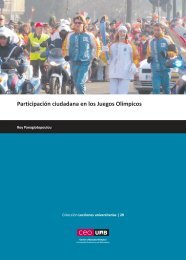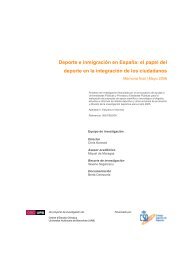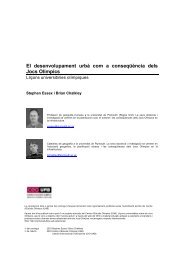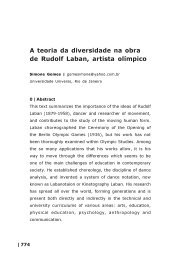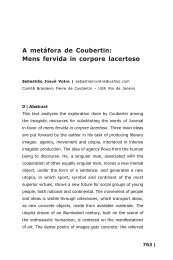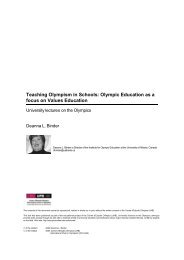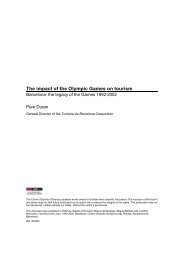The economic impact of the Barcelona Olympic Games, 1986-2004
The economic impact of the Barcelona Olympic Games, 1986-2004
The economic impact of the Barcelona Olympic Games, 1986-2004
Create successful ePaper yourself
Turn your PDF publications into a flip-book with our unique Google optimized e-Paper software.
© 2005 Centre d’Estudis Olímpics UAB<br />
Ferran Brunet - Economic <strong>impact</strong> <strong>of</strong> <strong>the</strong> <strong>Barcelona</strong> <strong>Olympic</strong> <strong>Games</strong><br />
multinationals, and suffers from shortcomings in public transport, language training, worker mobility and<br />
available development land, etc.), <strong>Barcelona</strong> continues to attract investment and enterprise.<br />
<strong>Barcelona</strong>, model and reality<br />
We can talk <strong>of</strong> a “<strong>Barcelona</strong> model” in three respects:<br />
√ A model for organisation <strong>of</strong> <strong>the</strong> <strong>Olympic</strong> <strong>Games</strong> (Figure 1).<br />
√ A model for <strong>economic</strong> <strong>impact</strong> <strong>of</strong> <strong>the</strong> <strong>Olympic</strong> <strong>Games</strong>, especially in terms <strong>of</strong> investments not<br />
directly linked to <strong>the</strong> <strong>Games</strong> (Figure 5).<br />
√ A model for urban transformation, improved attractiveness and strategic positioning (Figure 8).<br />
<strong>The</strong> use <strong>of</strong> <strong>the</strong> term “model” has become widespread and seems to have been accepted. In analytical<br />
terms, a model is an organised set <strong>of</strong> forms and procedures, shorn <strong>of</strong> accessories . However, in everyday<br />
usage, “model” includes <strong>the</strong> extra content, in this case <strong>the</strong> objectives and results.<br />
<strong>The</strong> objectives <strong>of</strong> <strong>Barcelona</strong>’92 were very clear (sporting and organisational excellence and <strong>the</strong> urban<br />
transformation <strong>of</strong> <strong>the</strong> city) and so were <strong>the</strong> procedures (institutional unity, mixed public-private funding,<br />
etc.). And since <strong>the</strong> results <strong>of</strong> this “<strong>Barcelona</strong> model” were positive, <strong>the</strong>n <strong>the</strong> term “model” is <strong>of</strong>ten used in<br />
<strong>the</strong> sense <strong>of</strong> being exemplary for o<strong>the</strong>r cities organising similar events. It seems that it did serve as a<br />
model in this sense for Sydney, and that it will also do so for A<strong>the</strong>ns and, possibly Beijing as well.<br />
<strong>Barcelona</strong> has <strong>the</strong>n become a model for o<strong>the</strong>r <strong>Olympic</strong> <strong>Games</strong> and cities .<br />
Conclusions<br />
Thanks to <strong>the</strong> <strong>Olympic</strong> <strong>Games</strong>, <strong>Barcelona</strong> is now a different city. <strong>The</strong> organisation was optimum, fostering<br />
massive investment in infrastructure. Thanks to correct use <strong>of</strong> <strong>the</strong> <strong>Olympic</strong> Legacy, increased capital and<br />
improved attractiveness, <strong>the</strong> urban development process has continued long after 1992.<br />
<strong>The</strong> organisation (Figures 1, 3 and 4), <strong>the</strong> investment (Tables 1 and 3), <strong>the</strong> <strong>economic</strong> and social <strong>impact</strong><br />
(Table 1, Figures 5 and 8), <strong>the</strong> urban transformation (Figure 5), <strong>the</strong> efficient use <strong>of</strong> <strong>the</strong> <strong>Olympic</strong> Legacy<br />
(Figure 8) were all highly positive. This is why we refer to <strong>the</strong> “<strong>Barcelona</strong> model” for organisation <strong>of</strong> mega-<br />
events, <strong>economic</strong> <strong>impact</strong> and urban transformation.<br />
<strong>The</strong> objective was quality, <strong>the</strong> implementation excellent, both in <strong>the</strong> preparatory and follow-up phase. Of<br />
equal importance however, was <strong>the</strong> city’s capacity to harness <strong>the</strong> <strong>Olympic</strong> impetus. Comparison with o<strong>the</strong>r<br />
<strong>Games</strong> and cities over <strong>the</strong> 1964-2008 period, shows that <strong>Barcelona</strong> was most successful in harnessing <strong>the</strong><br />
<strong>Olympic</strong> impetus and its <strong>impact</strong> (Figures 3, 7 and 9, Table 4).<br />
<strong>The</strong> continued investment in infrastructure and development driven by such events as <strong>the</strong> Forum, and<br />
development <strong>of</strong> <strong>the</strong> Poblenou district into a high-added value information and technology area, is <strong>the</strong> key<br />
to <strong>the</strong> city’s maintaining its 6th position among European cities .<br />
12




